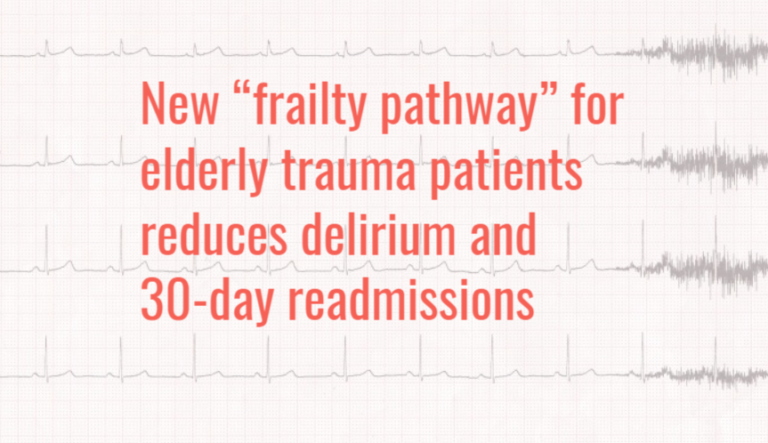Trauma surgeons at Brigham and Women’s Hospital in Boston have developed an interdisciplinary clinical pathway to identify and manage frailty in older trauma patients. The new care pathway has reduced the rate of delirium and the 30-day readmission rate.
A study describing the new pathway appears as an “article in press” on the Journal of the American College of Surgeons website. According to the study authors, the pathway implements standardized processes of care that a geriatrician would typically recommend for injured elderly patients.
Filling a gap in trauma care
The trauma surgery service at Brigham and Women’s Hospital hired a geriatrician to consult on elderly injury patients in 2014. Following this new hire, the team documented fewer complications, mortalities, readmissions and extended hospital stays. However, surgeons noticed gaps in care when the geriatrician was not available and lack of overall uniformity in the way recommendations from the geriatric team were instituted.
“It’s just not feasible to have a geriatrician available for consultation all the time,” said Zara Cooper, MD, FACS, associate professor of surgery at Harvard Medical School. “We needed to become better equipped to provide dedicated geriatric-focused care on our own. So we put some processes in place to screen elderly trauma patients for frailty and stratify and direct our resources to provide the best possible care for them.”
The trauma team at Brigham and Women’s Hospital developed the Frailty Identification and Care Pathway with input from geriatrics, nursing, nutrition, physical and occupational therapy, speech and language pathology, social work and care coordinators.
The pathway makes use of the five-item FRAIL scale to identify vulnerable elderly trauma patients. According to the Brigham Bulletin, patients who meet three or more of the following criteria are considered frail:
- Fatigue (“Are you fatigued?”)
- Resistance (“Can you climb one flight of stairs?”)
- Ambulation (“Can you walk one block?”)
- Illnesses (“Do you have more than five illnesses?”)
- Loss of weight (“Is your weight loss greater than five percent?”)
The frailty pathway also uses a standardized set of orders for geriatric-focused care and consultations, family meetings, and fall prevention education. It standardizes processes of care a geriatrician would typically recommend, including early ambulation, bowel and pain regimens, non-pharmacological delirium prevention, nutrition, physical therapy, and geriatric assessments.
In the present study, researchers reviewed 125 patients who were treated before the new frailty pathway was implemented and 144 patients treated after it was in place for six months. They found that patients managed according to the pathway had a 9% less risk for delirium, 3% less risk for mortality and 7% lower risk for readmission. There were no significant differences in risk for other complications.
Innovative models for geriatric trauma
Trauma protocols for the frail elderly will become increasingly important in the coming decades. By 2050, 40% of all trauma patients in the U.S. will be over age 65. As many as 50% of older trauma patients are frail, and 78% are functionally impaired.
“Trauma centers are primarily focused on hemorrhage and complications that are typical for young patients,” Dr. Cooper said. “The elderly, especially frail elderly, have very different needs. Innovative models for geriatric trauma patients are emerging in parts of the country that have a significant proportion of older adults.”
The frailty pathway at Brigham and Women’s Hospital is fairly straightforward and makes use of resources that are readily available in other trauma centers and surgical services. It is currently being expanded to frail elderly patients undergoing elective surgery.
“We have to adapt the protocol here and there, but the basic framework relies on getting patients mobile and managing medications, nutrition and communication with families,” Dr. Cooper said. “This is the type of care that matters to patients and should be universal.”

